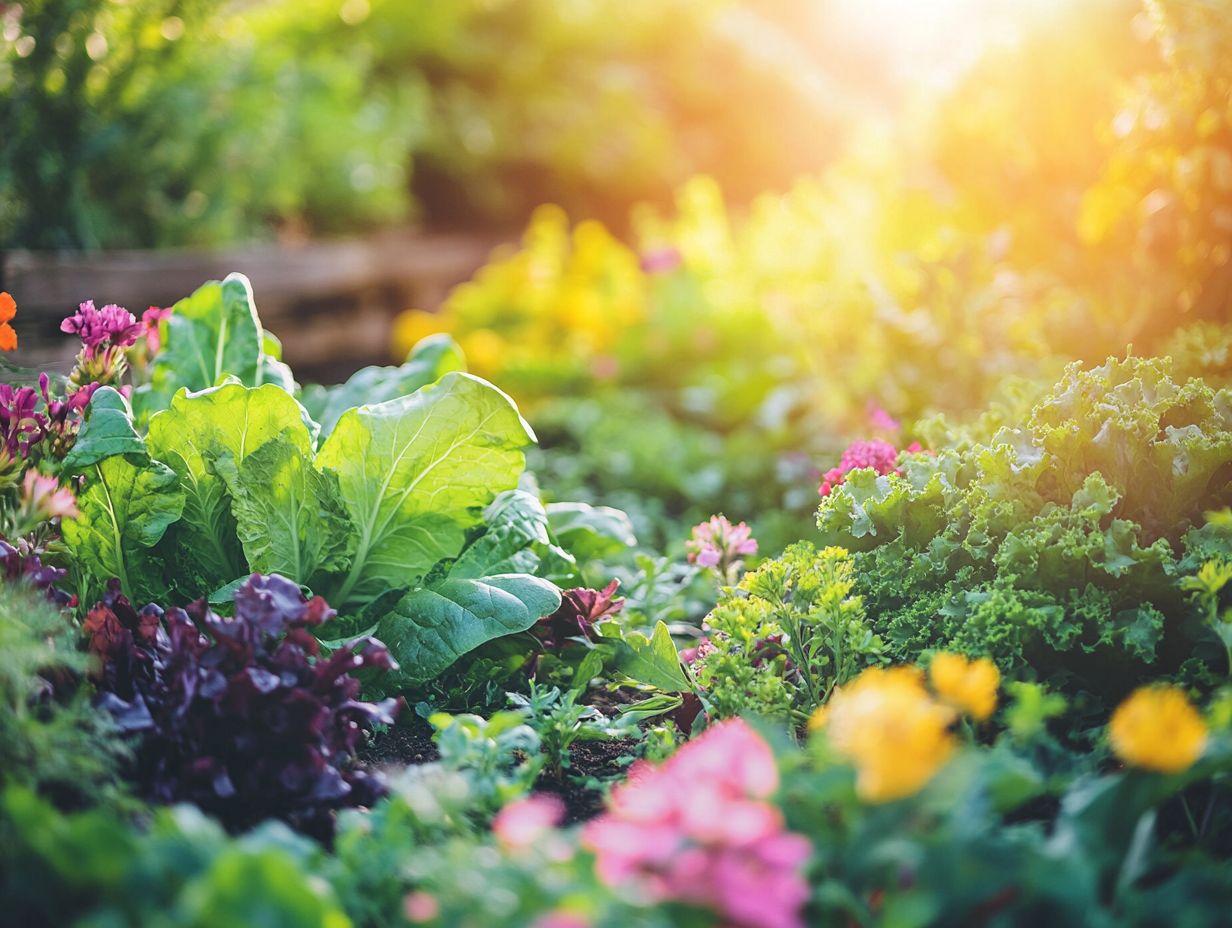What are the Benefits of Companion Planting?
Companion planting is a sophisticated gardening technique that strategically pairs plants together for mutual benefit, fostering a vibrant ecosystem in your garden.
This approach not only enhances natural pest control but also improves soil health and boosts crop yields. As you delve into the art of selecting the best companion plants, you’ll uncover successful combinations that can elevate your gardening game to new heights.
Embrace the powerful benefits of this time-honored practice and transform your gardening experience into something truly exceptional.
Contents
Key Takeaways:

- Companion planting is the practice of growing different plants together for mutual benefit.
- Natural pest control, improved soil health, and increased crop yields are some of the major benefits of companion planting.
- Choosing complementary plants and learning from successful examples can help you effectively implement companion planting in your garden.
What is Companion Planting?
Companion planting is a gardening method that positions different crops close to each other. This boosts growth, deters pests, and enhances biodiversity in your garden. This technique taps into natural plant benefits, where certain plants release helpful chemicals for their neighbors.
By understanding the unique roles that various crops play think plants that help add nutrients to the soil and aromatic herbs you can create a harmonious and productive environment that mirrors the complexity of nature. This leads to thriving plant partnerships and sustainable gardening practices.
Historically, forms of companion planting date back to Indigenous agricultural traditions, long before modern science weighed in. The principles behind these pairings echo insights offered by pioneers like Charles Darwin, who emphasized the interconnectedness of all life forms.
For example, marigolds repel nematodes, while tomatoes flourish alongside basil, enhancing their flavor and keeping pests at bay. Likewise, beans enrich the soil with nitrogen, making them excellent partners for corn.
By weaving these combinations into your gardening strategy, you cultivate not only a vibrant ecosystem but also highlight the importance of biodiversity and sustainable agricultural practices in your endeavors.
Benefits of Companion Planting
Unlock the incredible benefits of companion planting today! This method offers a wealth of strategies for effective pest control, increased crop production, and enhanced biodiversity within your garden ecosystem.
By embracing diversity, companion planting cultivates a more resilient garden. It naturally attracts beneficial insects and pollinators while skillfully managing pest populations through biological pest control methods. This holistic approach reduces your reliance on chemical pesticides and fosters a healthier environment for both your plants and the surrounding ecosystem.
Natural Pest Control
Natural pest control is a key benefit of companion planting. It encourages helpful insects that eat common pests like aphids and weeds. By employing techniques such as trap cropping growing specific plants to lure pests away from valuable crops you can effectively minimize pest damage without relying on chemical pesticides.
This organic approach enhances your garden’s ecosystem and promotes a delightful balance of natural enemies that contribute to a thriving environment.
Incorporating specific plant pairs can significantly elevate your gardening efforts. For instance, the vibrant marigold is celebrated for its ability to repel nematodes and other harmful insects, making it an excellent companion for your tomatoes and peppers.
Similarly, planting basil alongside tomatoes not only enhances flavor; it also deters pesky whiteflies and thrips, giving you a dual benefit. These strategies highlight the importance of maintaining biodiversity, as a varied plant selection creates a more resilient garden.
Ultimately, by embracing these natural pest control techniques within companion planting, you cultivate healthier crops while enriching your local ecosystem.
Improved Soil Health

Improved soil health is a remarkable advantage of companion planting. It allows you to make the most of your soil resources while enhancing nutrient availability through interplanting. Including nitrogen fixers like clover alongside your other crops can organically enrich the soil. This leads to healthier plants and improved yields.
This mutual benefit between plants fosters robust root systems and nurtures the overall health of your garden ecosystem. It promotes sustainable practices that align beautifully with organic gardening principles.
For instance, consider the compelling combination of beans and corn. Beans absorb nitrogen from the atmosphere and, through their root nodules, release it back into the soil. This provides a vital nutrient boost for the corn.
Interspersing organic matter from companion plants improves soil structure, enhancing both water retention and aeration. This natural process contributes to nutrient cycling and bolsters the microbial activity, which refers to the processes carried out by microorganisms and is essential for decomposing organic material.
Strategically pairing plants cultivates a thriving, self-sustaining environment that elevates your garden’s overall productivity!
Increased Crop Yields
Increased crop yields are one of the most exciting reasons to adopt companion planting practices! This method fosters diversity in your garden and optimizes resource use, leading to enhanced crop production. By strategically pairing plants like using corn to support beans you can maximize space and achieve impressive productivity levels.
This synergistic approach results in healthier plants and promotes sustainable agricultural practices that benefit both you and the environment.
Take, for example, planting marigolds alongside tomatoes. This clever pairing can deter pests, reducing your reliance on chemical pesticides while promoting robust tomato growth. Similarly, combining carrots and onions confuses pests, paving the way for a more bountiful harvest. Interplanting herbs like basil with peppers enhances flavor and keeps harmful insects at bay.
These successful partnerships contribute to greater yields and bolster the resilience of your ecosystem. They encourage beneficial insects and strengthen soil health. By embracing such intelligent pairings, you can elevate your productivity while nurturing a thriving, biodiverse environment.
How to Choose Companion Plants
Choosing companion plants is an essential step in elevating your companion planting game! When you select complementary plant combinations, you can substantially enhance the productivity and resilience of your organic garden.
By grasping the unique characteristics and growth habits of various plants, you can forge harmonious partnerships that optimize space, deter pests, and boost your overall yield. When choosing plants, think about their height, nutrient needs, and how well they work together.
Complementary Plant Combinations
Complementary plant combinations are essential for successful companion planting. They significantly enhance your garden’s productivity and pest management while adding visual appeal through natural barriers. Pairing plants that attract beneficial insects like aromatic herbs such as basil with tomatoes naturally deters pests and cultivates a vibrant ecosystem.
For example, when you pair marigolds with cucumbers, you can effectively repel aphids and nematodes while inviting pollinators like bees into your space. Similarly, planting garlic near roses helps fend off aphids and can even combat some fungal diseases.
These synergistic relationships support a sustainable gardening approach. You can reduce your reliance on chemical pesticides. Herbs like dill and fennel are excellent choices, as they attract ladybugs, which feast on aphids. This enhances your garden’s natural pest control.
Such thoughtful plant combinations maximize your garden’s productivity and create a thriving environment where every plant plays a vital role in nurturing one another.
Examples of Successful Companion Planting

Successful companion planting examples are plentiful. These plant pairs work in harmony to boost growth, repel pests, and enhance your garden’s overall health.
A classic example is the ‘Three Sisters Garden’ concept from Native American gardening. This method cultivates corn, beans, and squash together, forming a self-sustaining ecosystem that optimizes space and resources.
These time-tested combinations demonstrate companion planting’s ability to foster vibrant environments and promote sustainable agriculture.
Popular Plant Pairs and Their Benefits
Popular plant pairs in companion planting each provide unique benefits that elevate your organic garden. Marigolds, for instance, are known for repelling nematodes, making them excellent companions for tomatoes, which can attract various pests.
Beans help enrich the soil with nitrogen, boosting growth for nearby crops and showcasing the shared benefits of thoughtful plant combinations.
Consider the dynamic duo of basil and peppers. Basil not only enhances pepper flavor but also acts as a pest deterrent, keeping aphids and spider mites away. Another noteworthy combination is the Three Sisters corn, beans, and squash. Here, corn provides a sturdy framework for climbing beans, while beans enrich the soil and squash’s broad leaves shade the ground, suppressing weeds and retaining moisture.
By adopting these companion planting strategies, you can blend time-honored traditions with innovative techniques, creating a thriving ecosystem in your garden.
Frequently Asked Questions
What Are the Benefits of Companion Planting?
Companion planting means pairing different crops in your garden for better growth. These plants can have a harmonious relationship and offer numerous benefits, such as:
How Does Companion Planting Improve Soil Health?

Certain plants, like legumes, can fix nitrogen in the soil, a crucial nutrient for plant growth. By planting these alongside other crops, they help replenish and improve soil health.
What Are the Pest Control Benefits of Companion Planting?
Companion planting also aids in pest control. Some plants naturally repel pests, while others attract beneficial insects that prey on harmful ones. By planting these together, you can naturally protect your crops.
Can Companion Planting Increase Crop Yields?
Yes, companion planting can increase crop yields. A diverse ecosystem improves pollination, soil health, and pest control, all contributing to higher yields.
What Are Some Examples of Good Companion Plants?
Good companion plants vary depending on the specific crops you are growing. Common combinations include tomatoes and basil, corn and beans, and carrots and onions. Research which plants work well together in your garden.
Are There Any Other Benefits of Companion Planting?
Aside from the benefits mentioned, companion planting can suppress weeds and create a more visually appealing garden. It also promotes biodiversity and sustainability, making it an environmentally friendly practice.
Ready to transform your garden? Start companion planting today!






